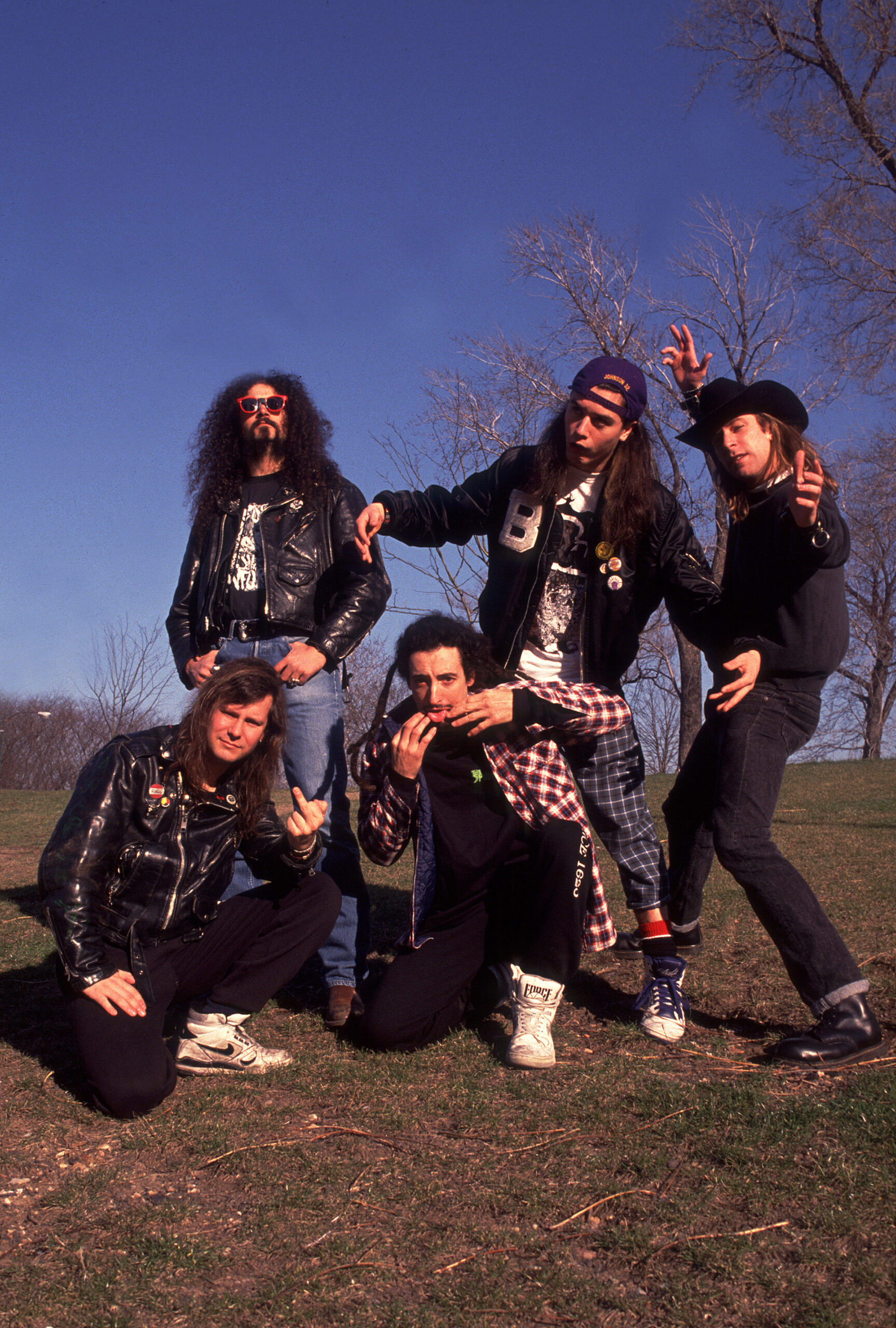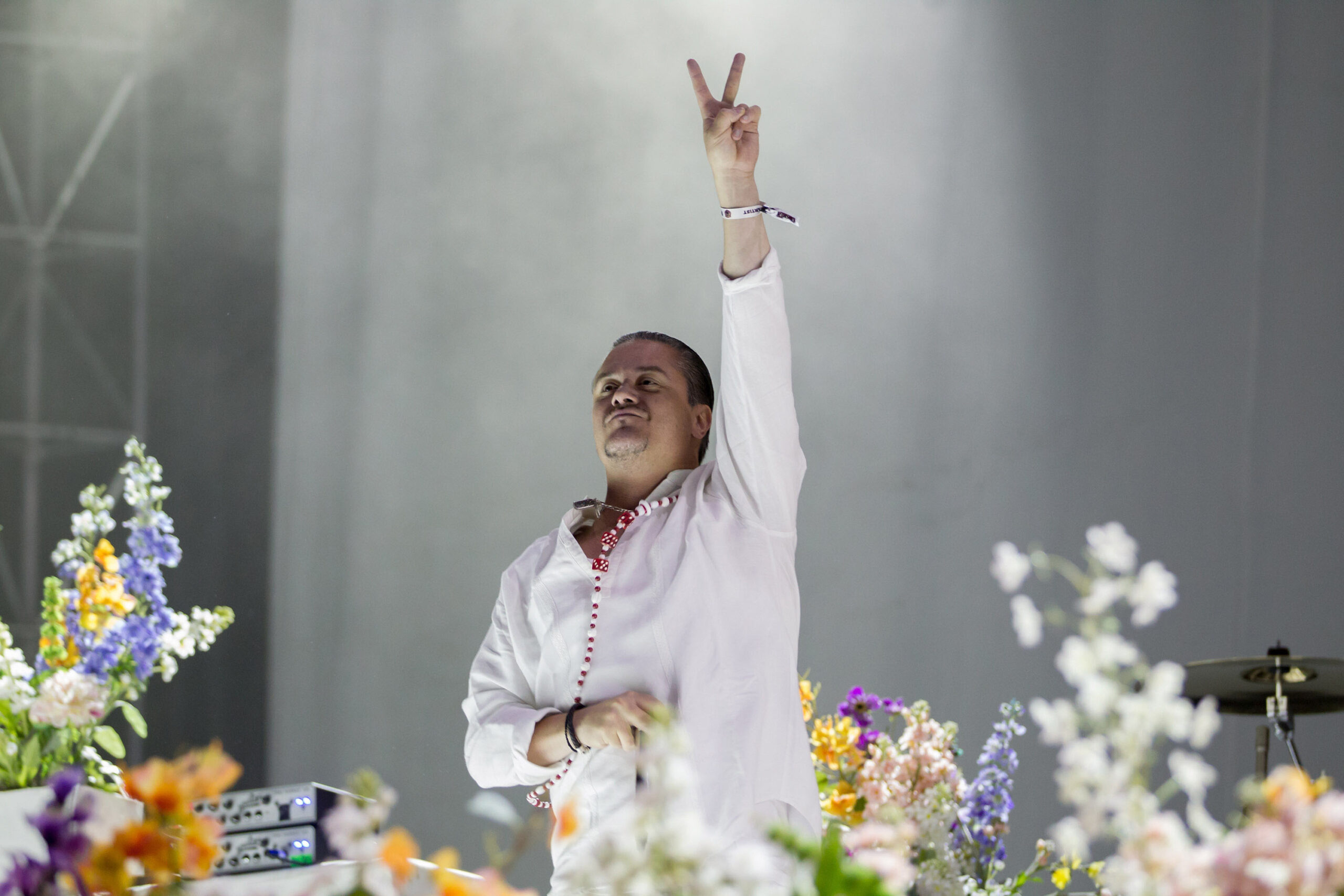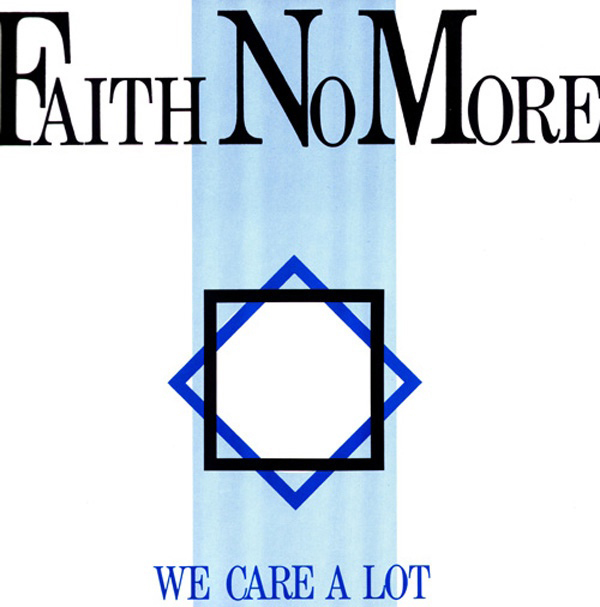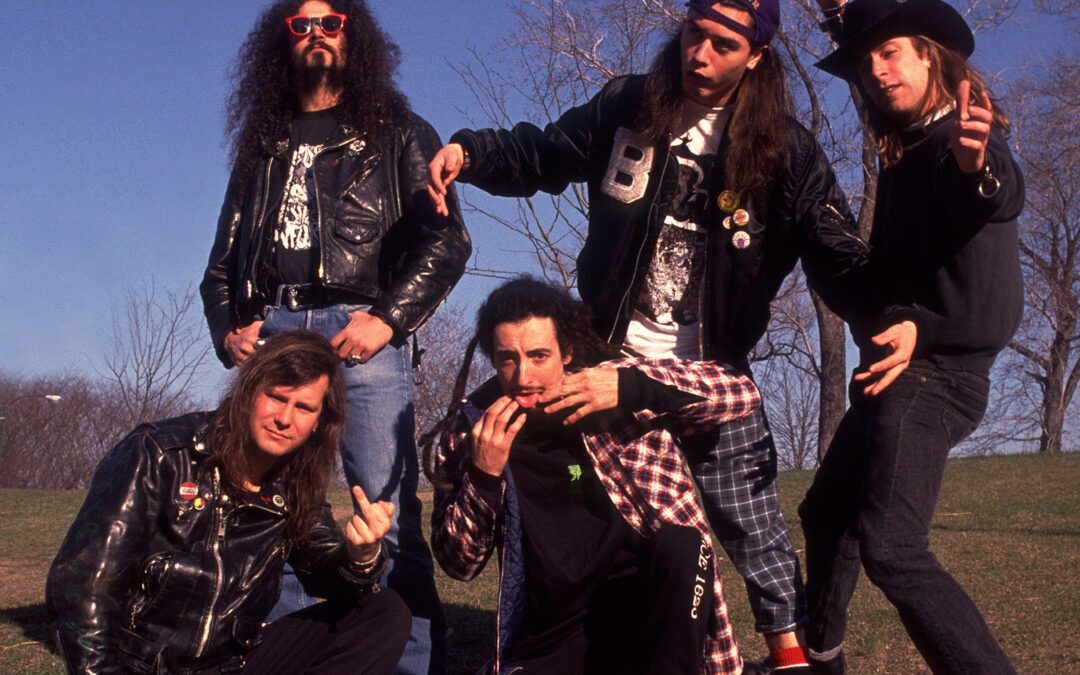Mojo
FEATURE
Welcome To The Freak Sh0w
Emerging from the US punk underground, they unwittingly became MTV’s alternative rock poster boys before alienating their entire audience and collapsing in a pool of their own vitriol. In 2015, eighteen years on from their last album, Faith No More’s unlikely return remained anchored in anger and indignation…

Introduce Yourself: Faith No More (front row, l-r) Billy Gould and Mike Bordin, (back row, l-r) Jim Martin, Mike Patton and Roddy Bottum. Chicago, Illinois 1990.
A one-time vaudeville house that was formerly a regular haunt of The Grateful Dead, tonight the stage at San Francisco’s Warfield Theater is decked in white and decorated with several florists’ worth of blooms, resembling a funeral in negative. The vibe is hardly sombre, however, the capacity crowd of 2,300 expressing an electric, impatient anticipation, hollering and stomping their feet. House lights dim and screams erupt as a spotlight tracks a figure walking onstage – not a member of the group, but a man dressed head-to-toe in black leather, sporting a gimp mask, who stands mute and static onstage. He will stay there during several songs in a gesture that, in its perverse absurdity, seems both very San Francisco, and very Faith No More.
Their last show in their hometown, in 2010, was Faith No More’s first on North American soil in over a decade, part of the Second Coming reunion tour that criss-crossed the globe over 87 shows between 2009 and 2012. That this epic (and lucrative) sortie only took in nine shows in the US perhaps reflects how these prophets of rage were ignored in their home-country after 1992’s Angel Dust wrong-footed their fanbase. By the time Faith No More announced their dissolution in 1998 – bidding sayonara with a maudlin cover of The Bee Gees’ I Started A Joke, the acerbic five-piece realising the joke was finally on them – America hardly seemed to care.
Now, everything is different. “We’re much more popular now than when we split up,” beams bassist Bill Gould, speaking earlier that day. Maturity and a fondness for each other bred by absence, meanwhile, has also softened their previously brutal internal dynamic. “We were young, and we just weren’t very good with each other,” he acknowledges. “We knew each other’s soft spots, and would lay into them.” Tonight, however, a pre-show huddle in the dressing room is scored not by savage zings but good-humoured guffaws, leading drummer Mike ‘Puffy’ Bordin to tell MOJO, as they troop to the stage, “You want to know what life in Faith No More is like now? Uproarious fuckin’ laughter!”
The show itself is scintillating, touring the vast sprawl of Faith No More’s sound – from the feral wall-of-noise assaults of Caffeine, to pop-savvy rap-metal anthem Epic, to a straight-faced cover of The Commodores’ MOR classic Easy (an unlikely UK Number 1 in 1993) – with a venom too vivid for mere nostalgia. Songs are plucked from Sol Invictus, their unexpected and widely acclaimed new album, announcing that for Faith No More, the reunion phase is over; now it’s time for the rebirth.
This turn of events clearly sits well with frontman Mike Patton, whose fearsome post-FNM workload suggested a man trying to put his past as far behind him as humanly possible. Tonight, as the lunatic fairground-ride of Land Of Sunshine draws to a close, he stands at the lip of the stage, pulls down the blood-red bandana across his face and unveils what can only be described as the shit-eating grin of vindication.
“Backstage at every show Guns N’ Roses had Jacuzzis and fake beaches populated by strippers. We laughed at how fucking ridiculous they were.”
Roddy Bottum
“We didn’t fit in with anybody,” remembers Bill Gould, of Faith No More’s earliest days. The group began in the early 80s, after Gould, drummer Bordin and keyboardist Roddy Bottum initiated a bloodless coup within Faith. No Man, the group 18-year-old LA native Gould joined a week after moving to San Francisco, ejecting mid-20s goth-loving singer Mike Morris. “I grew up on The Germs and Black Flag. I wasn’t into posing around in a dark coat,” smiles Gould, in one of the many teal-walled dressing rooms beneath The Warfield.
With Bordin under the spell of African percussion teacher CK Ladzepco, the trio swapped trad rock rhythms for epic, circular jams, playing with a slew of singers and guitarists at the few clubs in San Francisco that would book them. “We were about pushing buttons, instigating provocation,” remembers Bottum. One early vocalist, Courtney Love, excelled at the latter. “She was very extroverted,” grins Gould. “She would get up in the audience’s faces. She was not passive at all – people hated her! And we loved it.”
They picked up a guitarist, Jim Martin, who’d formerly played with Puffy and best friend, Metallica bassist Cliff Burton, in bar-band EZ Street. “We wanted a sound like the first Killing Joke record,” says Bottum, “Really tough, metal, aggro guitar, without solos and without the dumb attitude. And with Jim, we got a little of the attitude.” Martin, Bottum says admiringly, was a “weirdo”, a misfit even within this group of misfits, who often enjoyed wearing multiple pairs of glasses at once. “We were total extremes,” says Bottum. “He was a total redneck, a macho, gun-totin’, truck-drivin’ dude. I was a fruity, open-minded gay guy. We fought all the time, but I really liked him.”
Love, meanwhile, was replaced by Chuck Mosley, an old bandmate of Gould’s. “Whenever we’d play in LA, Chuck would hang out,” says Gould. “So we said, ‘Hey, there’s a microphone, there’s some beer, just start screaming.’ He was never a ‘singer’, but he had a great persona onstage, charming and really funny.”
Their debut album arrived in 1985, the maiden release by San Francisco indie Mordam Records. Its title track, We Care A Lot, was Faith No More’s first great song, welding Martin’s heavy-rock guitar to sparse funk and a rap puncturing of the pomposity of the Live Aid generation through its blackened lyricism. “We care a lot about disease / Baby, Rock Hudson, rock!” sang Mosley on the track released in the same year that the actor became the first high profile victim of AIDS.
“We were very sarcastic,” says Bottum, in what is a glorious understatement. “And that’s where We Care A Lot came from: it drew on the stuff we loved – Soulsonic Force, Kraftwerk, the first Run DMC album – while poking fun at modern culture and the media, stuff we thought was stupid.”
A second album, 1987’s Introduce Yourself, on Slash Records, refined Faith No More’s multifarious formula, but, says Gould, “Morale was horrible.” The source of the misery was Mosley, who often arrived at gigs with the band were already onstage, and, apparently exhausted, fell asleep onstage before an influential industry audience at the Introduce Yourself launch party at LA’s Club Lingerie.
“I exploded at him a couple of times,” says Gould. “We were at a gas station in Kentucky once, we’d driven all night, and he yelled at me, and I kicked him, and he started swinging at me like a wild man, and he broke his finger on the steering wheel. He was a good friend; I literally loved the guy. But we just had to make a change.”

The Real Thing: Mike Patton and Faith No More onstage at the Aftershock Festival, Sacramento, California in 2015.
“When did I realise I had a remarkable voice?” asks Mike Patton, archly raising an eyebrow in the Warfield dressing room. Not one to suffer fools, he repeats what appears to him to be a stupid question. “There’s not these watershed moments that look great in print. It’s a process. I’ve got a muscle, I got to exercise it. Most people run on a treadmill; I scream.”
The voice Patton’s currently downplaying is widely recognised as one of rock’s finest, its six-octave range the result of years of training. You can hear it in nascent form on YouTube footage as a 14-year-old Patton sings Judas Priest, Iron Maiden and Motley Crue with his band Gemini at Eureka High School’s 1984 talent show. A year later, he formed Mr Bungle with schoolmate Trey Spruance. “We were really into death metal and hardcore,” says Patton. “But it came out like we were almost a comedy troupe.”
Four years on, the Humboldt County native found himself in the abandoned animal hospital in San Francisco that Faith No More were using as both living quarters and rehearsal space. “He was like this innocent 19-year-old,” remembers Gould. “He must have been thinking, ‘What the fuck am I getting myself into?’”
Patton had earlier handed the group a Mr Bungle demo-tape at a gig in Humboldt, “because I thought they would get a laugh out of it.” Months later, he started receiving bizarre phone messages from Jim Martin. “He was like a poet, it was free-association wordplay,” laughs Patton. “I would play them to the band. We thought they might take us on tour. But Jim wanted me to be the new singer. I bet he thought I was some beer-bellied, mean redneck motherfucker.”
Faith No More played Patton their new music. Compared to Mr Bungle, the songs were “almost like pop,” remembers Patton, “and the chord-progressions reminded me of soul music. Death-metal soul music? That’s not going to work.” But as he improvised vocals over the nascent tunes, Patton realised, “it worked really good!”
“Mike had such diversity. He could really sing,” remembers Bottum. “And he had a similar sense of humour, laughing at the same things we were laughing at. It was super-clear he was a game-changer. ‘This is what we sound like with a real singer?’” “He was this young, innocent-looking kid,” adds Gould. “Our managers were like, ‘Ooh, we can sell this.’ But he really did ‘get’ it.”
Patton’s first album with the group, 1989’s The Real Thing was Faith No More’s most accessible release yet, though weirdness still coursed beneath its polished funk-rock surface, also harbouring brutal death-metal stomps, sinister doo-wop excursions and a most gonzoid thrash-prog instrumental entitled Woodpecker From Mars that Bottum refers to as “sort-of our take on the cinematic soundscapes of the Lawrence Of Arabia score.”
The band spent ten months touring the album; success was elusive, except in Britain. “I think we played England five times,” says Gould, “a bigger venue every time.” However, a manic 1990 show at London’s Astoria, where fans swarmed the stage, convinced label bigwigs to invest one final bundle of cash in promoting the album. A video was shot for Epic, and MTV finally fell for Patton’s All-American skate-punk looks and the track’s genius fusion of brat-rap and brawn-rock. The Real Thing began selling 20,000 copies a week, en route to sales that would top a million in the US alone.
This long-awaited success, however, proved bittersweet for the group as their audience grew. “The Real Thing found an audience with the metal kids, which was great,” says Gould. “But we were being perceived as something we weren’t. And when it came time for the follow-up, people were baying for The Real Thing Part II, and we didn’t want to make it.”
Two years spent on the road promoting The Real Thing, meanwhile, exacted its own price. “I’m sure it scarred us all, turned us into cockroaches rather than human beings,” says Puffy. “It drives you insane. And then you make an album like Angel Dust…”
“It’s like Sinatra said: the second time round, love is lovelier.”
Mike Bordin
Released in June 1992, in the era of Lollapalooza and Nirvana’s crossover success, Angel Dust was an explicit response to the success engendered by The Real Thing, a repudiation of whatever their new fans perceived Faith No More as being. “There was this gross miscalculation that we were some ‘mall metal’ band,” scowls Patton. “We needed to be who we were,” adds Gould. “We wanted to use this moment to do something cool, something badass.”
Hitherto polymorphous, on Angel Dust Faith No More got perverse. Gone was the glossy funk-metal of yore, replaced by a brilliantly incongruous riot of ideas, ricocheting between bangers that sounded like rave music on a battlefield (A Small Victory), waltzing Waitsian character-sketches (RV), ballistic industrial scourges (Malpractice). Patton was now as likely to scream, gurgle and howl as croon. “We wanted to go as far as we could,” says Puffy, of the album’s ambitions. “Evolve. That’s what we thought we were supposed to do.”
The response from management and the label was disheartening. “We played them the album, and they said, ‘I hope you didn’t buy houses already’,” deadpans Patton. There was dissension within, too: Jim Martin, whose heavy rock moves shaped The Real Thing’s success, saw no reason to change direction, telling journalists he didn’t like the new album. “That’s when the rift became irreversible,” says Gould. “Jim became a threat to our existence.”
A lengthy global tour with Guns’n’Roses only underlined their misfit status. ““We really fucked with G’n’R,” says Bottum. “We got kicked off the tour several times for talking shit about them in the press. Backstage at every show they had jacuzzis and fake beaches populated by strippers the road-crew had given laminates the night before. It was bananas. We just laughed at how fucking ridiculous they were.”
Patton, meanwhile, rebelled against his metal pin-up image, hacking off his locks, hiding his boyish good-looks behind a bristling chin-beard, and regaling credulous journalists with tales of shitting in hotel hand-dryers and drinking bootfuls of his own piss onstage. “It was just me having fun and cracking up my band-members,” he says, downplaying the stories but stopping short of denying them. “We freaked a lot of people out, but I’d realised, I’m not this person they think I am, and I can mess with them.”
July 1993, the band headlined the inaugural Phoenix Festival in Stratford-Upon-Avon, the final date of the Angel Dust tour. Bottum, hardly ever ‘in-the-closet’, had recently been ‘outed’ by the rock press, and asked the crowd, “heard any good rumours lately? It’s all true! Jim is gay!” “Everybody’s quitting!” added Patton. “It’s all over! It feels great!”
Fired that November, Jim Martin never played onstage with Faith No More again. “It’s like a high school break-up,” Gould says. “There’s a lot of pride involved. He maintains he quit the band.”
Gould had hoped that Martin’s exit would knit the remaining members closer together. Instead, Bottum sat out much of 1995’s King For A Day, Fool For A Lifetime, reeling from the deaths of both his father and close friend Kurt Cobain, and entering rehab for heroin addiction. “I didn’t handle it well,” says a regretful Gould. “I got angry at Roddy, like he was holding us back.” “It was our first real test,” nods Patton, who says the band were “all on different pages.”
Patton remembers “a funereal vibe” to the sessions for their sixth full-length, 1997’s Album Of The Year. “It seemed like a sad time. It’s a sombre record, I think we knew we were at the end.” “Nobody in our camp gave a shit about us, gave us any support at all,” adds Gould. The group toured for most of 1997. By spring the next year, the game was up.
The end came with a meeting at Bill Gould’s house. Patton arrived with a bottle of champagne. “I had a speech memorised, I wanted to make a ceremony out of it. And these guys looks at me like I was fucking crazy and said, ‘Why are you so upset? We agree with you!’”
There were, they say, no real regrets. “There was a waning of interest,” says Bottum, “and when that happens between close friends, it’s contagious. We all had other stuff we wanted to do. We were ready to turn our backs on it.”

1985’s We Care A Lot
Puffy says the members all had “jobs that kept us busy” during the years after the split. He drummed for Ozzy Osbourne, Roddy pursued his indie-rock group Imperial Teen, while Gould and Patton started their own labels (Koolarrow and Ipecac, respectively), Patton also juggling noise-rock supergroups, collaborations with Bjork, Norah Jones and Massive Attack, an album of covers of 50s/60s Italian pop, and a plethora of other projects, while Gould produced a number of acts.
If, during those fallow years, there was any demand in a Faith No More reunion, Patton says he didn’t hear about it. “Maybe I was sheltered from it.” “Our old agent sometimes hit me up,” says Gould. “But I wasn’t even really talking to the guys at that time. We weren’t enemies or anything, there was just a lot of baggage that came with our relationship. The situation had gotten very frustrating towards the end, and it was nice to take a vacation from it.”
Patton says it took “a growing-up phase” before he found himself in touch with his old band-mates again. “It took time. And also realising I’d spent half of my fucking life with these guys, and actually I really *do like them, and what we did was actually pretty good. We just had to bury some stuff first.”
When it came, the reunion was, unsurprisingly, tentative. “We were super-conscious,” says Patton. “Like, ‘Reunions? Who ever does those well? Nobody!’” “It was strange, how natural it all felt,” admits Gould. “Thirteen years went by, and we’re still telling the same jokes.” Still, no one took anything for granted, and there were no guarantees the reunion would remain ongoing. “On that first batch of shows, all I wanted to do was to say ‘Thank you’ to the fans,” says Puffy. “Because I didn’t think we were going to do any more at that point.”
Things seemed to run out of steam following a final show at London’s Brixton Academy in July 2012. Outwardly the group remained dormant through 2013. Summer 2014, however, saw the group support Black Sabbath at Hyde Park’s British Summer Time festival. Unexpectedly, their set featured two brand new songs – the slow-grind sleaze of Motherfucker (which became their ‘comeback’ track and, in typical provocative style, unplayable on the radio) and the schizophrenic thrash of Superhero – to the vintage setlist.
“I always thought we had more music in us, even when we split up,” says Gould. “I was hoping there would be a creative part to the reunion. Still, there was hesitation within the band to do anything to cash in on the reunion; we were just reconnecting as people, to bring cynicism into it… No.”
Late in 2012, and in secret, the group began to work on the new material, which took shape slowly. “We don’t all live in the same place,” says Gould, who helmed sessions at the group’s Oakland rehearsal space with Puffy and guitarist Jon Hudson (a member since Album Of The Year). Bottum, meanwhile, sometimes travelled in to contribute ideas and work on the nascent songs, and sometimes emailed in parts he’d recorded at home in NYC. “We’d get a lot of the music together before Patton jumped in and started working on it. We weren’t exactly all jamming in a room together,” he says. Despite its genesis and their fractured past, it’s clear Sol Invictus is nevertheless the product of communal creativity and a sense of genuine focus.
“If we didn’t like what we came up with, we wouldn’t make a record,” Gould says. “That was the bottom line.” “It was a super-scary proposition,” adds Bottum. “I didn’t want to hear that new Pixies album because chances are, they were going to fuck it up. But it was time to do something fresh, or stop doing it altogether. I think we pulled it off, in a good way.”
Revisiting their eclectic, cinematic sound while discovering new vistas and – most crucial of all – preserving their uniquely twisted, darkly sardonic character, Sol Invictus has solicited universal praise, emerging as the group’s strongest album since Angel Dust. And the group know it.
For Puffy, the most philosophical member of the group, this creative rebirth is the product of the tough times in-between. “It took us breaking up to get here,” he says. “To clean the slate. Because the baggage was piling up and most of it, in hindsight, was fucking petty.”
So is there a future beyond Sol Invictus? “I hate to talk about that shit, I don’t want to jinx it,” says Puffy. “But it’s like Sinatra said: the second time round, love is lovelier, it’s all so much better, and that’s cool.”
As far as Faith No More are concerned, then, the future really is unwritten. Only a fool would try and guess where it takes them next.
This article originally appeared in issue 260 of MOJO
Words: Stevie Chick Images: Getty

